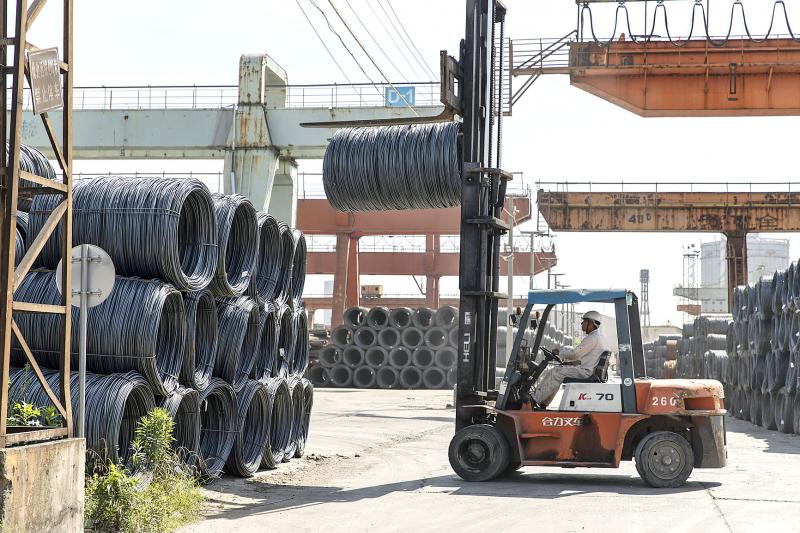China’s imports last month grew at their fastest pace in 10 years, fueled by surging demand for raw materials, although export growth slowed more than expected, weighed by disruptions caused by COVID-19 cases at the nation’s major southern ports.
While a brisk recovery in developed markets has bolstered demand for Chinese products, a global semiconductor shortage, higher raw material and freight costs, logistics bottlenecks and a strengthening yuan have dimmed the outlook for the world’s largest exporting nation.
China’s exports in US dollar terms grew 27.9 percent last month from a year earlier, slower than the 32.3 percent growth reported in April and missing analysts’ forecast of 32.1 percent.

Photo: Bloomberg
“Exports surprised a bit on the downside, maybe due to the COVID cases in Guangdong Province, which slowed down the turnover in Shenzhen and Guangzhou ports,” Pinpoint Asset Management Ltd chief economist Zhang Zhiwei (張智威) said, adding that turnover at ports in Guangdong is likely to remain slow this month.
Major shipping firms warned clients of worsening congestion at Shenzhen’s Yantian port in Guangdong Province after the discovery of several cases among port staff.
On the ground in Guangdong, factories have yet to report widespread capacity cuts over the outbreak, but admitted efficiency issues as they tried to meet overseas demand.
Chen Linsheng, chief operating officer at Anlan (安蘭), a Shenzhen-based manufacturer of skincare and beauty-care devices, said while there was no impact on production, staff are now subject to a series of COVID-19 tests and not allowed back into the factory without a negative result.
“We are not allowed going out [of the city]. We need to report in advance and cannot even go to Guangzhou or Foshan on our own,” Chen said, adding that a lot of meetings have moved back online.
Besides the impact of COVID-19 cases in Guangdong, the global chip shortage has started to hit all of China’s export items related to semiconductors, ING Bank NV chief economist for Greater China Iris Pang (彭藹嬈) said.
For example, auto processing products and parts, the biggest export item, fell 4 percent year-on-year, she said.
At the same time, the Chinese currency’s extended rally in the past few weeks to near three-year highs against the US dollar could further saddle US consumers with higher prices.
Imports increased 51.1 percent year-on-year last month in US dollar terms, the fastest growth since January 2011.
However, that figure — a gauge of import value, not volume — was partly flattered by hot raw materials prices with demand for commodities such as coal, steel, iron ore and copper driven by easing pandemic lockdowns in many countries and ample global liquidity.
Capital Economics Ltd senior China economist Julian Evans-Pritchard said while import prices increased at a rapid pace, import volume probably edged down last month.
“Once again, supply constraints are partly to blame – inbound shipments of semiconductors continued to drop back,” he said. “So too did imports of industrial metals.”
China posted a US$45.53 billion trade surplus for the month, wider than the US$42.86 billion surplus in April.

CHIP RACE: Three years of overbroad export controls drove foreign competitors to pursue their own AI chips, and ‘cost US taxpayers billions of dollars,’ Nvidia said China has figured out the US strategy for allowing it to buy Nvidia Corp’s H200s and is rejecting the artificial intelligence (AI) chip in favor of domestically developed semiconductors, White House AI adviser David Sacks said, citing news reports. US President Donald Trump on Monday said that he would allow shipments of Nvidia’s H200 chips to China, part of an administration effort backed by Sacks to challenge Chinese tech champions such as Huawei Technologies Co (華為) by bringing US competition to their home market. On Friday, Sacks signaled that he was uncertain about whether that approach would work. “They’re rejecting our chips,” Sacks

Taiwan’s exports soared 56 percent year-on-year to an all-time high of US$64.05 billion last month, propelled by surging global demand for artificial intelligence (AI), high-performance computing and cloud service infrastructure, the Ministry of Finance said yesterday. Department of Statistics Director-General Beatrice Tsai (蔡美娜) called the figure an unexpected upside surprise, citing a wave of technology orders from overseas customers alongside the usual year-end shopping season for technology products. Growth is likely to remain strong this month, she said, projecting a 40 percent to 45 percent expansion on an annual basis. The outperformance could prompt the Directorate-General of Budget, Accounting and

NATIONAL SECURITY: Intel’s testing of ACM tools despite US government control ‘highlights egregious gaps in US technology protection policies,’ a former official said Chipmaker Intel Corp has tested chipmaking tools this year from a toolmaker with deep roots in China and two overseas units that were targeted by US sanctions, according to two sources with direct knowledge of the matter. Intel, which fended off calls for its CEO’s resignation from US President Donald Trump in August over his alleged ties to China, got the tools from ACM Research Inc, a Fremont, California-based producer of chipmaking equipment. Two of ACM’s units, based in Shanghai and South Korea, were among a number of firms barred last year from receiving US technology over claims they have

BARRIERS: Gudeng’s chairman said it was unlikely that the US could replicate Taiwan’s science parks in Arizona, given its strict immigration policies and cultural differences Gudeng Precision Industrial Co (家登), which supplies wafer pods to the world’s major semiconductor firms, yesterday said it is in no rush to set up production in the US due to high costs. The company supplies its customers through a warehouse in Arizona jointly operated by TSS Holdings Ltd (德鑫控股), a joint holding of Gudeng and 17 Taiwanese firms in the semiconductor supply chain, including specialty plastic compounds producer Nytex Composites Co (耐特) and automated material handling system supplier Symtek Automation Asia Co (迅得). While the company has long been exploring the feasibility of setting up production in the US to address